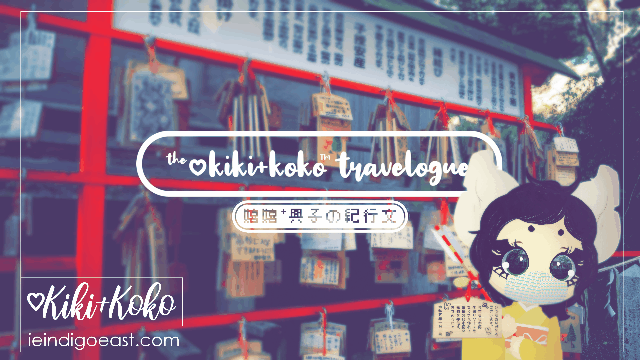
皆様、こんにちにゃあぁ!Welcome to Kiki+Koko: Let’s NihonGO!! Online. We’re your personal guides to Japanese language and culture, Kiki and Koko! We’re always looking towards the future, aiming for the next goal, reaching for the next milestone, trying to provide the best for you, and supporting you along your journey. You’re driven, ready to take on the next challenge, foraging for every last opportunity for advancement. That’s not to say that’s the only way to learn, though. Many others are relaxed, cruising down the motorway of their Japanese language learning path. They’re about the journey, just picking up what they wish along the way, looking ahead, but just enjoying the now. Each of these ideas covers what we’ve already presented you, the non-past tense verbs of Japanese. But, what does this mean?
 Well, no matter if the verbs are 辞書形, jishokei, or マス形, masukei, the forms that are presented as vocabulary in Japanese are what many JSL teachers would call non-past tense. As we presented in the introduction to 動詞, doushi, these forms aren’t quite so easily categorised as present tense, as it may be confused with another type of present progressive tense that we’ll explain in future. It’s a bit difficult to fathom in a different way than non-past, because saying something as 「話す」can be (I) speak, as in a general statement, just meaning that the subject speaks in general, and in that same way, it can be that ([Any Subject]) speaks. The commonly misconstrued myth that Japanese has no way to express future tense definitively may be confused because of the fact that this non-past tense verb can also express future tense depending on context, such as:
Well, no matter if the verbs are 辞書形, jishokei, or マス形, masukei, the forms that are presented as vocabulary in Japanese are what many JSL teachers would call non-past tense. As we presented in the introduction to 動詞, doushi, these forms aren’t quite so easily categorised as present tense, as it may be confused with another type of present progressive tense that we’ll explain in future. It’s a bit difficult to fathom in a different way than non-past, because saying something as 「話す」can be (I) speak, as in a general statement, just meaning that the subject speaks in general, and in that same way, it can be that ([Any Subject]) speaks. The commonly misconstrued myth that Japanese has no way to express future tense definitively may be confused because of the fact that this non-past tense verb can also express future tense depending on context, such as:
「私が 話します。」「I (will) speak.」
It could easily mean, ‘I speak’, but if, perhaps, the person was asking, ‘who wants to speak next?’ at a meeting, in class, at a party, or something of that nature, then the person would be implying (when they reply with said non-past tense) that they will speak rather than the general ability to speak. Or perhaps, a 小さくて赤い雌鶏、chiisakute akai mendori, a little red hen asks, who will eat this bread, then perhaps one would say:
「私が 食べます。」「I (will) eat (it).」
You’ll notice in these cases, the context there’s a specification with the 助詞, joshi, or the particle, showing the emphasis on who will be doing the action. This is a bit of the context we were speaking of in the previous examples. If you see 「は」, it usually implies a general action, that it’s something one does, again, not something that one has the potential to do. Though, logically, saying that so-and-so does something means they can do it, but linguistically, you should be sure not to confuse this general non-past tense with the potential form which isn’t just describing what the subject does but what the subject CAN do.
This may seem like quite a bit to suss out at first, but no worries, we’ll be there with you each and every step of the way! That’s why we’re taking it one step at a time. Whether you’re cruising down the autobahn of Japanese language, just living in the moment and enjoying the lessons whilst just sort of learning through osmosis, or you’re taking each one of these lessons like a serious survival situation in the middle of the forest that is Japanese language, being sure to take each and every piece of sustenance you can to survive; we’ll be right there for you, either pointing out pathways and helping you clear them, or handing you snacks during your road trip. (Just try not to get any crumbs in the cushions.)
 And, whilst talking about generalities and the future is an important part of speech, it’s equally important to talk about what you’ve done in the past. Looking back at one’s accomplishments is an important way to motivate you throughout your language learning journey, but it’s also an invaluable skill in Japanese! Many concepts have the vital need for a past tense even when speaking the simplest of Japanese sentences. However, there is another layer to this. As was hopefully learnt in the previous introductory lessons, there are a few different categories in the hierarchy of Japanese verbs. But, for now, and even then, you’ll really only have to think about 辞書形, jishokei, or マス形, masukei, as each of these major categories conjugates differently. However, the true stepping stone in all of this is 辞書形, jishokei, as it’s the gateway to being conjugated into マス形, masukei. Though, this lesson, we’re going to give you a bit of an easier way into conjugating to past tense. Even though we will definitely be guiding you through the all-important 辞書形, jishokei, conjugation with all of its るs and うs, we’re going to give you a pathway to at least expressing past tense through the objectively simpler way (once you have learnt how to conjugate 辞書形, jishokei, into マス形, masukei). This is just so you can at least get the satisfaction of using these right away and being able to have another opportunity to practise your conjugation to マス形, masukei. This will definitely be the ナ形容詞, な adjectives, to the イ形容詞, い adjectives, or the 一段活用、ichidan conjugation, to the 五段活用, godan conjugation, when it comes to verbs. (There is oddly always a simpler class, then a bit more multi-faceted class when it comes to all of the topics that we’ve covered so far.) But, again, we will be beginning this with continuing the saga of マス形, masukei, teaching you its 過去形, kakokei, or past tense/form~!
And, whilst talking about generalities and the future is an important part of speech, it’s equally important to talk about what you’ve done in the past. Looking back at one’s accomplishments is an important way to motivate you throughout your language learning journey, but it’s also an invaluable skill in Japanese! Many concepts have the vital need for a past tense even when speaking the simplest of Japanese sentences. However, there is another layer to this. As was hopefully learnt in the previous introductory lessons, there are a few different categories in the hierarchy of Japanese verbs. But, for now, and even then, you’ll really only have to think about 辞書形, jishokei, or マス形, masukei, as each of these major categories conjugates differently. However, the true stepping stone in all of this is 辞書形, jishokei, as it’s the gateway to being conjugated into マス形, masukei. Though, this lesson, we’re going to give you a bit of an easier way into conjugating to past tense. Even though we will definitely be guiding you through the all-important 辞書形, jishokei, conjugation with all of its るs and うs, we’re going to give you a pathway to at least expressing past tense through the objectively simpler way (once you have learnt how to conjugate 辞書形, jishokei, into マス形, masukei). This is just so you can at least get the satisfaction of using these right away and being able to have another opportunity to practise your conjugation to マス形, masukei. This will definitely be the ナ形容詞, な adjectives, to the イ形容詞, い adjectives, or the 一段活用、ichidan conjugation, to the 五段活用, godan conjugation, when it comes to verbs. (There is oddly always a simpler class, then a bit more multi-faceted class when it comes to all of the topics that we’ve covered so far.) But, again, we will be beginning this with continuing the saga of マス形, masukei, teaching you its 過去形, kakokei, or past tense/form~!
Talking of past-tense, you’ll definitely want to have, in a perfect world, have been keeping up with the lessons since the beginning. It really helps you to continue on the same track and path, understanding each lesson based on the building blocks we’ve set out to get a better view of everything. And, also, it helps so we don’t have to repeat information you may already know from previous lessons, bogging them down. (Though, revision / studying is very important, but hopefully, this keeps things a bit more streamlined.) But, we understand, sometimes you want fast facts, and we’re here for that as well, for you! In this case, you’ll definitely want to have at least a basic understanding of 動詞, doushi, and how they function as well as their classes and types. It simply assists in making this make a bit more sense as if you started with no knowledge of verbs, then jumped straight into past tense of マス形, masukei, firstly, you would probably wonder what is a マス形, masukei, and can I get a cute face printed on mine? (To which we would direct you towards a マスク, masuku). But, nevertheless! We want to be sure you understand the beats we’re laying down, so be sure you’re prepared with these important tools before heading out into the big wide world with us. (Digitally, of course.)
Oh! But, don’t forget, whilst knowing about the parts of speech are important, you’ll also want a grasp of how to create sentences, particles, and other essential grammatical features. For that, you can have a look at the grammar section of the essentials, or if you’d like the very latest, as it takes a bit sometimes to get each of them categorised, you can be sure to search the latest articles and lessons from us. We’ll be right here for you when you return from the past, right here in the present tense!
Yay! You’ve returned to us after a long and arduous journey, gathering the previous tools for this excursion! Or perhaps you’ve just scrolled down a bit? Maybe you’ve already learnt those, or you’ve already revised a bit for one day. Either way, it’s time to travel to the past once more, or at least teach you how to express it. This will be a general how-to, but we’ll also explain a few things along the way to assist you further. So, without further ado, let’s jump right into it! Let’s NihonGO!!
Masu Form’s Past Tense | マス形の過去形
(+ Desu past tense |「です」の過去形)
 As you hopefully remember from the previous lessons, if you have a verb 𝕤𝕥𝕣𝕒𝕚𝕘𝕙𝕥 𝕠𝕦𝕥𝕥𝕒 the dictionary, and you want to sound a bit more put-together or want to communicate with someone you don’t know or who is of a higher status, you’ll want to use マス形、masu form. So, this means, you’ll only be able to apply this technique after you’ve already changed a 辞書形 into マス形. However, depending on the way you look at it, there is some crossover with other conjugation methods. We’re going to show you a few ways to think about this that may actually assist you in conjugation for other types of verbs in future. As with our previous lessons, though the end product is the same, for some, there are just simpler ways of thinking about it that can help you more than others. But, for some, another way may feel like it makes more sense. Let’s start with an example:
As you hopefully remember from the previous lessons, if you have a verb 𝕤𝕥𝕣𝕒𝕚𝕘𝕙𝕥 𝕠𝕦𝕥𝕥𝕒 the dictionary, and you want to sound a bit more put-together or want to communicate with someone you don’t know or who is of a higher status, you’ll want to use マス形、masu form. So, this means, you’ll only be able to apply this technique after you’ve already changed a 辞書形 into マス形. However, depending on the way you look at it, there is some crossover with other conjugation methods. We’re going to show you a few ways to think about this that may actually assist you in conjugation for other types of verbs in future. As with our previous lessons, though the end product is the same, for some, there are just simpler ways of thinking about it that can help you more than others. But, for some, another way may feel like it makes more sense. Let’s start with an example:
Let’s say you’re starting with a verb that’s already in マス形, masukei:
話します→ 話し+ました→話しました。
はなします→ はなし+ました→はなしました。
hanashimasu→ hanashi+mashita→hanashimashita。
In this case, it would be expressing ‘speak’ to ‘spoke’. Now, one thing that may make this feel a bit better is that this is already simpler than the irregularity of the English word ‘speak’. Whilst this method seems simple enough, simply removing the ます ending and adding the ました ending, when some conjugate a ます ending to past tense, it can feel simpler to some, but more complex to others, to simply think of it this way:
話します→ 話しま+した→話しました。
はなします→ はなしま+した→はなしました。
hanashimasu→ hanashima+shita→hanashimashita。
In this case, you’re taking the ending of the verb and you’re changing end 「す」 and you’re changing it to 「した」which is what one would do if they saw a 「す」at the end of a verb to make it past tense.
Why this may feel more complicated to some is because it can be easier for some to simply group all of it together, and it may make it a bit confusing when you get to conjugating dictionary forms, or at the same time, it may end up making it a bit easier for others. It’s a strange balance, but whichever you feel most comfortable with is alright as long as you can keep track of it.
What may cause things to be less confusing for those that like to use the idea of cutting off the end or adding different set endings, you may enjoy this method better, such as: What if your verb is in 辞書形, jishokei? Well, first, you’re going to want to convert it into 連用形, ren’youkei, conjunctive form, which we explained in the マス形とは?|What is Masu form? lesson along with verb stems intro| identifying verb types & stems. But, once you’ve reached that step, all you have to do is add the ending:
話し+ました→話しました。
はなし+ました→はなしました。
hanashi+mashita→hanashimashita。
Now, one other thing you may begin to notice once you start conjugating is that these words get to feel more than a bit long when using romaji. That’s why it’s best to learn or begin learning how to at least read hiragana with us as it really does visually make things much smoother to read. Sometimes, a word looking long in romaji may be enough to scare one off. So, be sure to give yourself the best chance if you’re really serious about delving deeper into the fascinating and fun forest of Japanese language.
 But, returning back to the topic at hand, there is another reason why people may favour that previous method of looking at the す→した method over the ます→ました thought process. In this case, it means that one can look at the two different ways of having basic politeness in a sentence in the same way. Sometimes grouping ideas together can make things simpler, or they can make them more complicated, so just go with whatever makes the most sense to you and sort of ‘clicks’ the best.
But, returning back to the topic at hand, there is another reason why people may favour that previous method of looking at the す→した method over the ます→ました thought process. In this case, it means that one can look at the two different ways of having basic politeness in a sentence in the same way. Sometimes grouping ideas together can make things simpler, or they can make them more complicated, so just go with whatever makes the most sense to you and sort of ‘clicks’ the best.
So, when you think of it in the second way, it makes conjugating です into past tense feel like it makes a bit more sense, but you can always think of it as two completely separate words, as well, which can make it make a bit more sense if the ます→ました idea works best for you. But, remember, this is a special case verb that is a copula, so be sure to get an understanding of what 「です」actually is before taking this method to heart:
です→ で+した→でした。
desu→ de+shita→deshita。
But, on the other end of things, those who would rather think of it as a whole replacement, some simply think of it as:
です→でした。
desu→deshita。
This cuts out the middle man, makes things simpler for some and just makes it another vocabulary word rather than a specific conjugation in ones mindーdespite it being just that.
Though once they are conjugated to マス形, masukei, they all take on the same way of becoming past tense, perhaps it would still be useful to take a look at some examples:
洗います→洗いました
あらいます→あらいました
araimasu→araimshita
書きます→書きました
かきます→かきました
kakimasu→kakimshita
書きます→書きました
かきます→かきました
kakimasu→kakimshita
食べます→書きました
かきます→かきました
kakimasu→kakimshita
And, that’s definitely why we put so much emphasis on understanding how to conjugate to the next form, because once you understand the basis of the first conjugation, you’ll be able to understand as more pieces are added to the puzzle. In many cases, it’s very much about understanding how to conjugate the dictionary form, but for these simpler cases, it should hopefully make enough sense to become a bit more second nature. Once you feel comfortable with the first type of conjugation, it oddly makes the next one a little bit easier to transition into. That’s not to say that they’re easy due to knowing the first pieces, but it makes it much more fathomable than if you hadn’t. These all definitely take multiple exposures and practice in order to fully feel comfortable with these, especially in every day speech. So, just give yourself a chance, be patient, and let yourself go at your own pace. If it seems a bit much at first, just have a bit of a rest from it and come back to it later. The more you wrap your mind around any new concept, the more natural it will become. And, it’s always best to approach this with a positive and relaxed attitude rather than stressing out about it. It’s all supposed to be something new and enjoyable! Anything fun usually takes at least a bit of effort.
How do you pronounce the した ending?
New language learners of Japanese are usually tempted to put emphasis on し・ た in past tense endings, which would make sense from an outside perspective. But, native speakers, even in many other words, when presented with し next to た, the い sound totally disappears, sounding more like sshta. So, usually, as a rule of thumb, when you see a し next to た, the い sound will go away. That isn’t to say you’ll never hear it, though. If it’s a word beginning with し next to た, there may be some people that pronounce it, but even then, usually, you’ll hear the same truncated prononciation.
Though, let’s say you’re really enunciating to make a point. Like, someone asks:
「稲荷寿司は どこ?」(Where’s the inarizushi)
Then someone could cheekily respond:
「食・べ・ま・し・た。」(I ate it~)
It’s a special way of being cheeky or silly, cute or angry, or just literally enunciating how to say or pronounce something. It’s something we’ll get into in further depth, certain types of enunciation and their meanings in a way that should be conducive to understanding.
Most Word of the Week segments include sentences that use this sound of した, so if you’re interested in hearing it in different contexts, definitely feel free to take a stroll and have a listen.
Can you list past tense verbs in マス形?
Well, just like we introduced in the adjective section, there is actually a way to do this. However, in usual everyday speech, you’ll end up listing verbs in dictionary form. That isn’t to say that there aren’t cases where you’ll see or hear listed verbs in their basic polite form of マス形. This is where 「テ形」, tekei, comes into play, which we will cover in a future lesson.
But, overall, the same sort of idea applies to this as it does to adjectives. the initial verbs are in present tense, but the last verb in the series will take on the past tense to make the list complete. Though we haven’t gone over this yet, as of this lesson’s release, though we will in another lesson. But, for now, an example may make this at least a little clearer, using verbs we’ve presented in the Basic Classroom Vocabulary series.
昨日は、本を 読んで ゴミを 捨てて ノートに 書きました。
きのうは、ほんを よんで ごみを すてて のーとに かきました。
kinou wa, hon wo yonde, gomi wo sutete, nooto ni kakimashita.
Yesterday, (I) read a book, threw away rubbish, and wrote in my notebook.
Basically, the last verb affects the previous ones. This is why we were sure to introduce this concept with adjectives so that you could get a bit of a sense for it. And, hopefully, this at least gives you an idea of how it works. But, even still, there will be plenty of chances to practise this idea in future.
And, with that, we’ve reached the end of this lesson! Hopefully, this is a good first step into past tense verbs for you and will prepare you for the perhaps more complex ones you’ll encounter in future. Just remember when the time arrives that there’s no time limites on learning something correctly. It’s important to give yourself a chance and not to rush yourself. And, if you ever do find yourself overwhelmed, be sure to have a rest and try again at another time when you’re in a better head space. With a positive attitude and a bit of effort, anything is possible! And, we understand, not every day can you feel like learning Japanese is your biggest passion. Sometimes your energy will ebb and flow. But, as long as you just stick with it during the ebbs, giving yourself time and maybe approaching it with a more relaxed attitude, you’ll thank yourself during the times you find yourself very eager to learn. At least introducing yourself to concepts and having exposure to new concepts can be the key to understanding future topics, and giving yourself a head start, and not leaving yourself too far behind. Even still, we’ll be there for you no matter your goals, whether you’d rather just dabble to strengthen your mind or you want to become completely fluent.
We hope that we’ve continued to be a useful source for your Japanese studies. We want to be there for you in your Japanese language learning journey for years to come. Your support helps others just like you who also want to continue to keep these educational tools available to everyone. Perhaps during your busy week, you may forget which days we upload, or what day of the week it is. By subscribing to the Electronic Mailing List of Tomorrow, today, found usually at the bottom of the site page or the sidebar on desktop, you won’t ever have to remember what day of the week it is, again! Also, you’ll be the first to be notified as otherwise, hours before everyone else. You’ll get the latest tools and resources to surviving in Japanese language in straight to your inbox. That’s articles, videos, podcasts, and more.

Grooving to the content we’re creating? You can leave a TIP in the TIP♡JAR to keep it going!
(Can’t? No worries! The content is free for everyone! We’re just glad you’re here!! Bring friends if you like~!)
Again, we want to make sure we can continue to offer extended and essential resources as well as even more content for months and years to come whilst also surviving with food and shelter. It’s usually one or the other, otherwise. If you want to ensure our survival as well as the continuation of the creation of new and even better content, feel free to leave a TIP in the TIP♡JAR to keep it going, or for long term contributions in increments, you can join our Patreon where our gracious host, Indigo East, usually posts behind-the-scenes, sneak-peeks, exclusive content, and more. And, we join in as well! Again, if you’d like to support our survival and the creation of more content to be made available to as many people as possible, you can also share the content! You can easily share via Twitter and Pinterest where you can retweet and repin respectively without even having to type! Gestures like that go a long way, and we appreciate it.
Thank you for having us! We hope that you continue with us on this adventure, and we appreciate that you’ve chosen us to assist you on your Japanese learning journey!
![]()
Stay Safe!!
♡Kiki+Koko






Assist our friendly world domination and follow us via The Internet.




































6 replies »